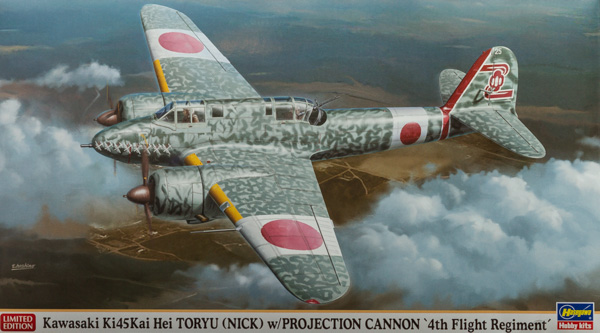
Hasegawa 1/72 Kawasaki Ki-45Kai Hei Toryu (Nick) w/Projection Cannon "4th Flight Regiment"
By Chris Banyai-Riepl
Overview
The origins of the Kawasaki Ki-45 are interesting, as it was a plane that almost wasn't. In the 1930s, when many nations were looking at twin-engined designs for fighters, Kawasaki followed the pack with their original Ki-45 design. The performance was severely lacking, and while this initial design was rejected, the Japanese government did provide suggestions for improvement. Kawasaki wisely decided to hand the project off to Doi Takeo, the designer who came up with the successful Ki-48 bomber. The result was a significant departure from the original Ki-45, and the Ki-45kai exceeded the IJA specifications. Nearly 1700 were built before the end of the war.
The Kit
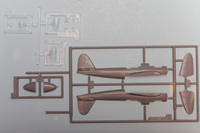 The Hasegawa 1/72 Ki-45 kit has been around for a while, so it was due for a re-release. This edition is the Ki-45Kai Hei version, which has a Ho-203 37mm cannon in the nose. The kit is molded in the usual Hasegawa gray plastic, with nicely recessed panel lines throughout and a simple interior. The decal sheet is colorful and features two options, both from the 4th Flight Regiment.
The Hasegawa 1/72 Ki-45 kit has been around for a while, so it was due for a re-release. This edition is the Ki-45Kai Hei version, which has a Ho-203 37mm cannon in the nose. The kit is molded in the usual Hasegawa gray plastic, with nicely recessed panel lines throughout and a simple interior. The decal sheet is colorful and features two options, both from the 4th Flight Regiment.
Construction starts with the interior, and this definitely is an area that shows the age of the kit. The overall detailing is simplistic, but it does provide a solid starting point for those who want to add more. There is a one-piece floor that gets two bulkheads, one behind the pilot's seat and one in front of the observer's seat. Both seats are separate, as is the instrument panel, control column, and rear gun mount. The only detailing added comes in the form of a decal instrument panel. By adding seat belts and a couple styrene boxes, you can give quite a bit of life to this interior. For the more detail oriented, it might be best to just track down a photoetch or resin update.
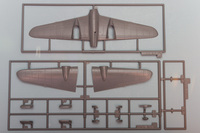 With the interior together, the assembly goes pretty fast. The fuselage is split into halves, which trap the completed interior inside. The stabilizers are solid right and left halves, while the wings are in three pieces. The one-piece lower wing also incorporates the aft portion of the engine nacelles, along with part of the wheel well, and the center fuselage section extends beyond the leading and trailing edges of the wing. This will make filling that seam much easier than trying to work around the wing root.
With the interior together, the assembly goes pretty fast. The fuselage is split into halves, which trap the completed interior inside. The stabilizers are solid right and left halves, while the wings are in three pieces. The one-piece lower wing also incorporates the aft portion of the engine nacelles, along with part of the wheel well, and the center fuselage section extends beyond the leading and trailing edges of the wing. This will make filling that seam much easier than trying to work around the wing root.
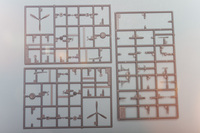 For the engines themselves, these are made up from three main pieces for each cowl, plus two more parts for the mounting point to the nacelle. The lower intake scoop is separate and in two pieces for each engine, and the exhaust pipes are also separate. While there are quite a few parts involved here, the overall assembly is pretty straightforward.
For the engines themselves, these are made up from three main pieces for each cowl, plus two more parts for the mounting point to the nacelle. The lower intake scoop is separate and in two pieces for each engine, and the exhaust pipes are also separate. While there are quite a few parts involved here, the overall assembly is pretty straightforward.
For the landing gear, these get separate oleo scissors for the main gear, with one-piece wheels. The retraction strut is separate as well, and the end result is a pretty good representation of the Ki-45kai's landing gear. The final step is attaching the rear gun, radio antenna mast, and canopy, and then attention can turn towards finishing.
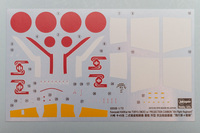 The paint scheme for both options is the same, with the plane finished in overall gray green with dark green squiggly lines painted on the upper surface. The first option was flown by 2nd Lt Sadamitsu Kimura from Ozuki Airfield, Yamaguchi, in 1945, while the second was an unknown Ki-45Kai from Ozuki Airfifeld in 1944. Both have the white bands around the hinomarus, with tail stripes and markings for the 4th Flight Regiment. The decals include the white bands and yellow wing leading edges, for those who don't want to mask and paint those areas.
The paint scheme for both options is the same, with the plane finished in overall gray green with dark green squiggly lines painted on the upper surface. The first option was flown by 2nd Lt Sadamitsu Kimura from Ozuki Airfield, Yamaguchi, in 1945, while the second was an unknown Ki-45Kai from Ozuki Airfifeld in 1944. Both have the white bands around the hinomarus, with tail stripes and markings for the 4th Flight Regiment. The decals include the white bands and yellow wing leading edges, for those who don't want to mask and paint those areas.
Conclusion
This is still the best choice for a 1/72 Ki-45kai, and it builds up into a very nice representation of the real thing. While the cockpit interior might not be up to current modeling standards, it is easy enough to add a bit extra there and should not be a deterrent to picking this kit up. My thanks to Hasegawa USA for the review sample.
